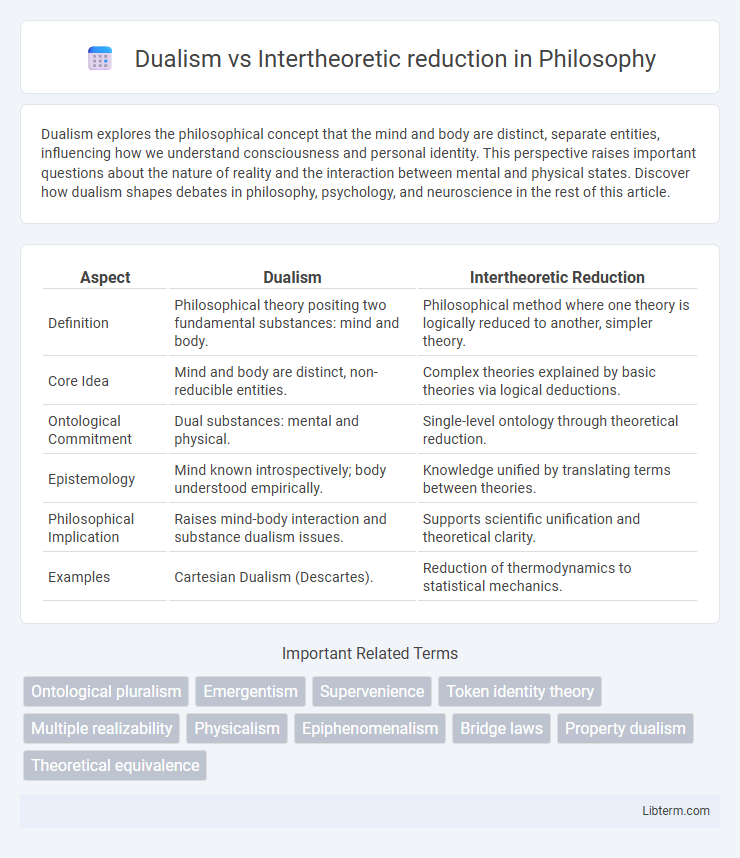Dualism explores the philosophical concept that the mind and body are distinct, separate entities, influencing how we understand consciousness and personal identity. This perspective raises important questions about the nature of reality and the interaction between mental and physical states. Discover how dualism shapes debates in philosophy, psychology, and neuroscience in the rest of this article.
Table of Comparison
| Aspect | Dualism | Intertheoretic Reduction |
|---|---|---|
| Definition | Philosophical theory positing two fundamental substances: mind and body. | Philosophical method where one theory is logically reduced to another, simpler theory. |
| Core Idea | Mind and body are distinct, non-reducible entities. | Complex theories explained by basic theories via logical deductions. |
| Ontological Commitment | Dual substances: mental and physical. | Single-level ontology through theoretical reduction. |
| Epistemology | Mind known introspectively; body understood empirically. | Knowledge unified by translating terms between theories. |
| Philosophical Implication | Raises mind-body interaction and substance dualism issues. | Supports scientific unification and theoretical clarity. |
| Examples | Cartesian Dualism (Descartes). | Reduction of thermodynamics to statistical mechanics. |
Introduction to Dualism and Intertheoretic Reduction
Dualism posits that mind and body are distinct substances, emphasizing the irreducibility of mental states to physical phenomena. Intertheoretic reduction aims to systematically translate terms and laws of one theory into another, often more fundamental, scientific framework. This approach seeks to unify disparate theories by demonstrating that higher-level concepts can be fully explained through lower-level scientific principles.
Historical Background of Dualism
Dualism, historically rooted in the philosophy of Rene Descartes in the 17th century, posits the existence of two distinct substances: mind and body, emphasizing a fundamental separation between mental and physical realms. This view contrasts with intertheoretic reduction, a 20th-century development in philosophy of science aiming to explain higher-level theories by reducing them to more fundamental ones, typically in physicalist terms. The historical background of dualism highlights enduring metaphysical debates about consciousness and identity, shaping subsequent theories on the mind-body relationship.
Emergence of Intertheoretic Reduction
The emergence of intertheoretic reduction marked a pivotal shift in philosophy of science, emphasizing the systematic translation of one theoretical framework into another to demonstrate scientific unity. This process contrasts sharply with dualism, which maintains the separation of distinct theoretical domains, such as mind and body. Intertheoretic reduction leverages logical and empirical bridge principles to connect and reduce complex phenomena from higher-level theories to fundamental laws, facilitating a cohesive scientific worldview.
Core Principles of Dualism
Dualism centers on the principle that mind and body are fundamentally distinct substances, with mental states irreducible to physical states. It asserts the existence of two separate ontological categories: the mental and the physical, each governed by different properties and laws. This core principle challenges physicalist perspectives, emphasizing the autonomy and non-reducibility of conscious experience in philosophical and scientific analysis.
Main Concepts in Intertheoretic Reduction
Intertheoretic reduction involves systematically mapping the concepts and laws of one scientific theory onto those of a more fundamental theory, ensuring explanatory coherence and continuity. Key concepts include derivability, where the reduced theory's laws are deduced from the reducing theory; definability, which requires the precise definition of reduced terms using the reducing theory's vocabulary; and correspondence rules that link theoretical entities across frameworks. This systematic approach contrasts with dualism's rejection of such reduction, emphasizing the ontological independence of mind and body.
Key Differences Between Dualism and Reductionism
Dualism asserts the existence of two fundamentally distinct substances or realms, typically mind and body, emphasizing their irreducible differences in nature. Intertheoretic reduction, a principle in philosophy of science, seeks to explain one theory entirely in terms of another, highlighting a hierarchical relationship where higher-level theories reduce to more fundamental physical theories. The key difference lies in dualism's commitment to ontological pluralism versus reductionism's aim for theoretical unification and elimination of ontological duality.
Philosophical Debates Surrounding Both Theories
Dualism posits the existence of distinct mental and physical substances, sparking debate over the nature of consciousness and its non-reducibility to physical processes. Intertheoretic reduction attempts to explain one theory entirely within the framework of another, often provoking contention about the loss of explanatory power and the oversimplification of complex phenomena. Philosophers challenge dualism's metaphysical duality while scrutinizing intertheoretic reduction's feasibility in preserving theoretical integrity across disciplines.
Implications for Philosophy of Mind
Dualism posits a fundamental ontological distinction between mind and body, asserting non-physical mental substances or properties that resist reduction to physical explanations. Intertheoretic reduction seeks to unify psychological phenomena under neuroscientific or physical laws by systematically translating mental states into brain states, posing challenges for dualistic accounts. The implications for the philosophy of mind involve debates on consciousness, mental causation, and the adequacy of physicalist explanations versus the persistence of irreducible mental phenomena.
Contemporary Perspectives and Critiques
Contemporary perspectives on dualism emphasize the persistent challenges in reconciling mind-body interaction with physicalist frameworks, highlighting issues such as mental causation and the explanatory gap. Intertheoretic reduction, while advocating for the unification of psychological phenomena under neuroscientific laws, faces critiques regarding the complexity and autonomy of higher-level cognitive functions that resist straightforward reduction. Current debates focus on hybrid models, like non-reductive physicalism and emergentism, seeking to integrate dualist intuitions with scientific rigor to address limitations inherent in both dualism and strict intertheoretic reduction.
Conclusion and Future Directions
The conclusion highlights that dualism presents inherent challenges in integrating mental and physical phenomena, whereas intertheoretic reduction offers a promising framework for unifying scientific theories through systematic translation of concepts and laws. Future directions emphasize advancing computational models and empirical research to refine reductionist approaches, while exploring nuanced dualistic perspectives that accommodate emerging findings in cognitive science and quantum mechanics. Enhanced interdisciplinary methodologies could bridge existing gaps, fostering a more comprehensive understanding of consciousness and physical reality.
Dualism Infographic

 libterm.com
libterm.com